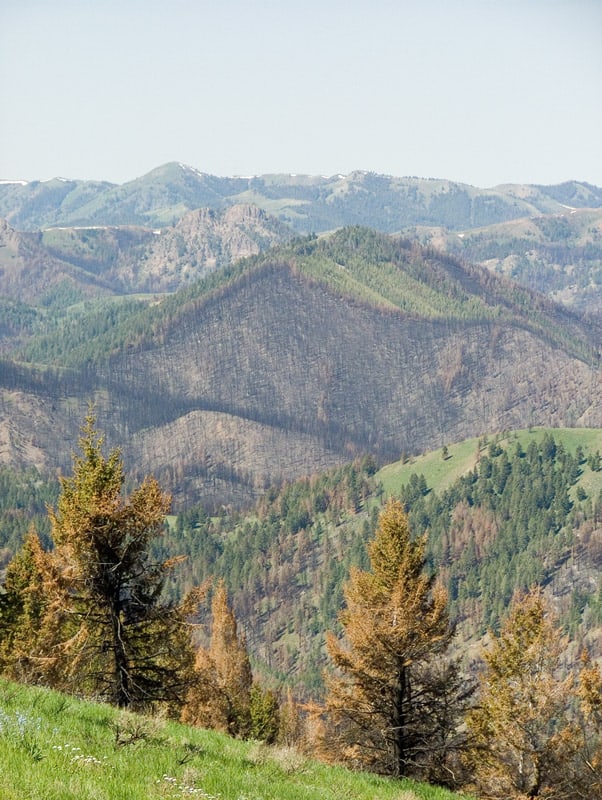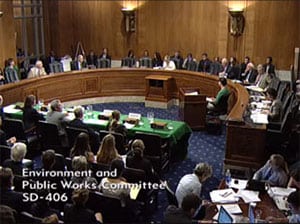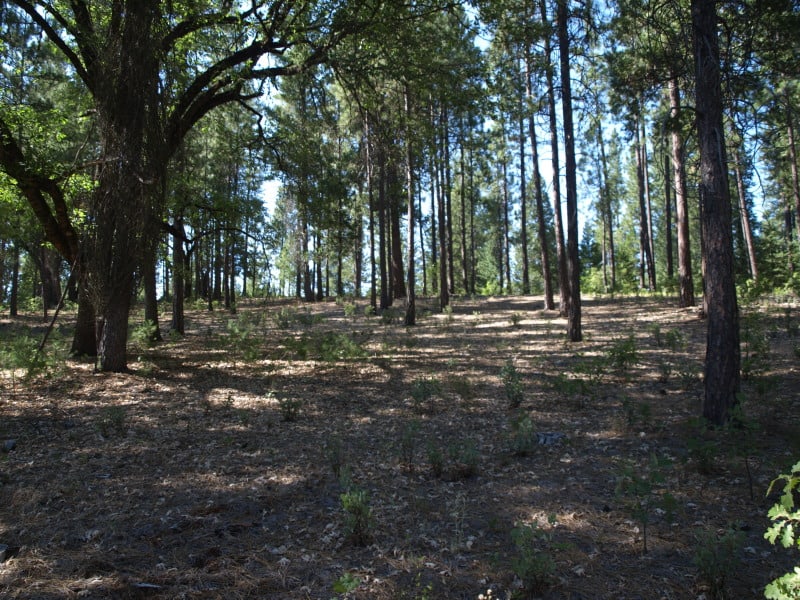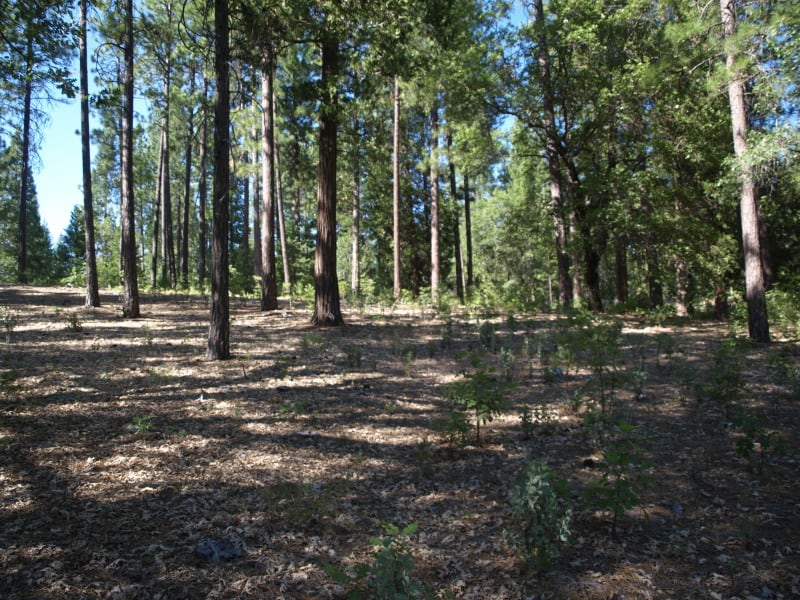The Beaver Creek Fire has burned over 90,000 acres of the Sawtooth National Forest. This is a view (from the top of Sun Valley Ski Area) of the land after the Castle Rock Fire, of 2007. The Beaver Creek Fire is burning up to and into the footprint of the old fire. As you can see, the fires here can jump around a lot, finding new “jackpots” of fuels, on the north-facing slopes. Some of the acres burned are grass and sagebrush, too. Yes, there ARE some VERY fancy homes in and around the town of Ketchum. Will this be the fire that burns down part of the community?
Fire Acreage in 2013 Question
I’ve been interested in fire acreages since the discussion of the black-backed woodpecker habitat.
I ran across this story this AM. It sounded like the Beaver Creek fire was 85 square miles. That seems pretty big to me. But then at the end of the story they talked about the Pony Complex (229 square miles).
So naturally I got curious about all of the current acreages.Here is a great NIFC site that tells you many things you might want to know. What I thought was interesting was that this year at this date, we seem to have a lot fewer wildfire acres than in past years. I wonder if I am reading this wrong?
Also the Beaver Creek link seems to be broken, I wonder if it got subsumed into another fire?
Advice for Experts Giving Congressional Testimony
I know we have a variety of readers, and who knows, some of them may be giving testimony and would appreciate helpful advice. This is from Roger Pielke, Jr. .
Here’s an excerpt:
Independent experts not affiliated with formal assessments are also commonly invited to provide testimony. A specific expert is asked to testify because policy makers see some political advantage in having that expert testify. Academics unaffiliated with government, advocacy groups, or formal scientific assessments should quickly disabuse themselves of any notion that they have been invited to “speak truth to power.” Rather, they are carefully selected for the perceived political benefits of their testimony.
In my case, I was invited by Republicans on the Senate committee because several Democrats, including President Obama, have recently been making statements about the relationship between human-caused climate change and extreme weather that go well beyond what can be supported based on current scientific understandings. The previous time that I testified before this same committee, I was invited by Democrats. An expert cannot control when their knowledge will be perceived as relevant, or by whom; but when an invitation is received, we have an obligation to participate in the democratic process.
Expertise is commonly brought into the political process through some overt political conflict, as politicians seek to hold each other accountable for public representations that invoke claims grounded in science. This strategy was on display in the Senate hearing, when a Democratic senator queried me on the reality of climate change – an issue on which we agreed – but steered clear of the substance of my testimony, which focused on extreme events.
Experts offering evidence in such an unavoidably political process need to remember that their job is not to tell policy makers what they want to hear, but to provide their best judgment about what the evidence can support on subjects in which they have some expertise. While this is an easy recommendation to make, there is no shortage of experts willing to engage in stealth advocacy by presenting a view of evidence that is friendly to a partisan agenda by engaging in cherry picking of research or even offering misleading or unsupportable testimony. Those tactics were fully on display at the Senate hearing in which I participated, and are unavoidably fundamental to the process.
Each of us “independent” experts afforded the privilege of participating in the democratic process by delivering evidence has to decide what role we wish to play. I have long argued that stealth advocacy by experts — while seductive and offering a quick route to political impact — ultimately risks the legitimacy and authority of expertise, especially the ability of the expert community to offer effective science arbitration or honest brokering. The flip side, of course, is that in the context of the most politicized issues, representations of evidence that do not fit a partisan agenda may simply not be welcome in the process, especially if it is equivocal, nuanced, or uncertain.
The expert can reduce the odds of merely serving as a political prop in a larger debate by asking policy makers what specific questions they would like to see addressed in the testimony. In my testimony before the Senate last month, I was asked to testify about extreme weather, a subject I have been researching for more than 20 years. In the vocabulary of The Honest Broker (Cambridge, 2007), I assumed the role of the “science arbiter.” I was not asked to share my strongly held views on a carbon tax, light bulb standards, global energy access, or the reform of FIFA. Staying focused requires discipline, restraint, and a healthy respect for the process.
NY Times on Wolf Delisting
A Times’ editorial today:
Editorial
Wolves Under Review
By THE EDITORIAL BOARD
Published: August 15, 2013
In June, the Fish and Wildlife Service prematurely proposed to end federal protection for gray wolves in the lower 48 states in the belief that wolves had fully recovered from near eradication in the early 20th century. This was politics masquerading as science. The Fish and Wildlife Service would love to shed the responsibility of protecting large carnivores, like the wolf and the grizzly bear, and hunters and ranchers throughout the Rocky Mountains would love to see wolves eradicated all over again.
By law, a decision like this one — to remove an animal from the endangered species list — requires a peer review: an impartial examination of wolf numbers, population dynamics and the consequences of proposed actions. But science and politics have gotten tangled up again. The private contractor, a consulting firm called AMEC, which was hired to run the review, removed three scientists from the review panel. Each of the scientists had signed a May 21 letter to Sally Jewell, the interior secretary, criticizing the plan to turn wolf management over to the states.
In the peer-review process, there is only the illusion of independence, for the simple reason that the Fish and Wildlife Service controls the appointment of panelists. The agency would like to pretend that these panelists were removed for their lack of impartiality. In fact, they failed to measure up to the agency’s anti-wolf bias. The Fish and Wildlife Service is now busy covering its tracks. It postponed evaluation of the delisting plan because, it says, the identities of the panelists, which were supposed to be hidden from agency officials, had been discovered.
If wolves can’t get a fair hearing at the federal level, what chance do they have at the state level? The answer is, very little. Scientists have already noted a 7 percent decline in Rocky Mountain wolves since they were delisted, and hunts authorized, in Idaho, Montana and Wyoming.
Wolves arouse passions that seem to preclude any effort to treat them the way they should be treated: as part of a natural, healthy ecosystem. That is how the Clinton administration understood wolves when it reintroduced them to the region in the mid-1990s, and it’s how they should be understood now.
Watch Out For Pot Growers: Weapons and Chemicals
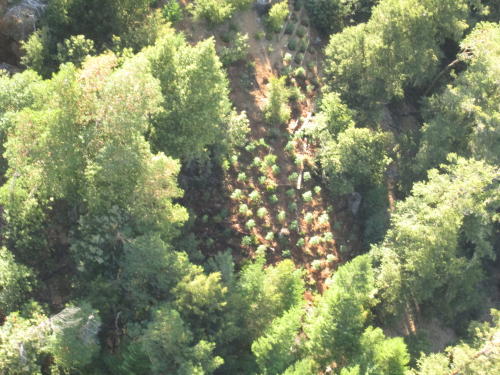
Here’s a news story from California.
Below is an excerpt.
When deputies arrived on scene they located a large marijuana growing operation containing 5,266 growing marijuana plants ranging in size from 1′ to 4′ in height. They also located an armed suspect in the garden who was arrested. The suspect was identified as Andres Montes-Deoca, 21 years old, from Mexico. When deputies arrested Montes-Deoca he was wearing a loaded 9 mm semi-automatic handgun.
Officers also located a Rodenticides and Carbofuran in the garden site.
I remember using carbofuran on pine seedlings for (root weevils??) It was 35 or so years ago. I remember that stuff being very bad and here’s a wikipedia entry that it’s indeed very, very bad for many organisms including humans.
Carbofuran is highly toxic to vertebrates with an oral LD50 of 8–14 mg/kg in rats and 19 mg/kg in dogs.[citation needed]
Carbofuran is known to be particularly toxic to birds. In its granular form, a single grain will kill a bird. Birds often eat numerous grains of the pesticide, mistaking them for seeds, and then die shortly thereafter. Before the granular form was banned by U.S. Environmental Protection Agency in 1991,[11] it was blamed for millions of bird deaths per year. The liquid version of the pesticide is less hazardous to birds since they are not as likely to ingest it directly, but it is still very hazardous. The EPA announced on July 25, 2008 that it intends to ban all forms in the US.[12] The ban requires that no residue be present on domestic or imported foods.[13]
Carbofuran has been illegally used to intentionally poison wildlife in the US, Canada and Great Britain; poisoned wildlife have included coyotes, kites, golden eagles and buzzards. Secondary fatal poisoning of domestic and wild animals has been documented,[14][15] specifically, raptors (bald eagles and golden eagles), domestic dogs, raccoons, vultures and other scavengers. In Kenya, farmers are using carbofuran to kill lions and other predators.[9][16]
In a number of publicized incidents worldwide, carbofuran has also been used to poison domestic pets.[17][18]
Toxicity to humansCarbofuran has one of the highest acute toxicities to humans of any insecticide widely used on field crops (only aldicarb and parathion are more toxic). A quarter teaspoon (1 mL) can be fatal.[citation needed] Most carbofuran is applied by commercial applicators using closed systems with engineered controls so there is no exposure to it in preparation. Since its toxic effects are due to its activity as a cholinesterase inhibitor it is considered a neurotoxic pesticide.
Carbofuran is also a powerful endocrine disruptor that can cause transient alterations in the concentration of many hormones in animals and humans even at extremely low doses. These alterations may consequently lead to serious reproductive problems following repeated exposure.[19][20] In one study, the exposure of rats to sublethal amounts of carbofuran decreased testosterone by 88%, while the levels of progesterone, cortisol, and estradiol were significantly increased (1279%, 202%, and 150%, respectively).[19]
Carbofuran can also be toxic to testes in sublethal amounts. A decrease in sperm motility, sperm count along with increase in percent abnormal sperm was observed at 0.4 mg/kg dose level.[21]
Senator Udall on Biomass Plant in Gypsum
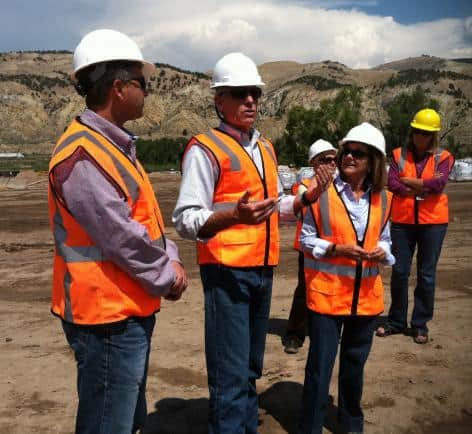
Here’s the link and below is an excerpt.
GYPSUM — U.S. Sen. Mark Udall said the Gypsum biomass power plant is a “win-win-win” project when he and state Sen. Gail Schwartz toured the plant’s construction site on Friday afternoon.
The Gypsum biomass plant is the first of its kind in Colorado and is on schedule to go online this December. The “woody” biomass plant will produce 11.5 megawatts of electricity per year by burning dead timber collected mostly from the White River National Forest. That main fuel source will be supplemented by other sources, such as wood construction waste that normally goes to the landfill. Of the 11.5 megawatts, 10 megawatts will be sold annually to Holy Cross Energy through a 20-year agreement and 1.5 megawatts will power the plant itself.
“When this goes online it will put us over the top of our goal to have 20 percent of our power coming from renewable energy by 2015,” said Holy Cross CEO Del Worley. “This will put us at around 22 or 23.5 percent renewable energy.”
Udall, who serves on the Energy and Natural Resources Committee, touted the public-private project as a fine example of how to bolster the economy and help the environment while generating domestic power.
“It’s a carbon-neutral, renewable energy source, it mitigates forest wildfire, it creates about 100 jobs in total and it’s going to be profitable,” Udall said. “There’s nothing wrong with profit — profit leads to reinvestment.”
Eagle Valley Clean Energy LLC — a subsidiary of Evergreen Clean Energy Corporation — is the company behind the Gypsum plant, which will get the bulk of its fuel from West Range Reclamation LLC. West Range is a forest and land management company in Hotchkiss that was recently awarded a long-term stewardship contract with the U.S. Forest Service. West Range will receive $8.66 million through the 10-year contract.
“The stewardship contract is at the heart of this,” Udall said. “It’s a beautifully fulfilling relationship.”
Environmental health
Schwartz said Colorado is 37th in the nation for utilizing biomass power but it is the No. 1 producer of biomass fuels.
“We have 4 to 6 million acres of standing dead timber in our state,” she said. “We have 175,000 slash piles in Colorado that we will burn anyway. This biomass plant will help clean our forest and mitigate wildfires as well as create jobs and electricity.”
Udall said the biomass plant is a market-based solution.
“[Eagle Valley Clean Energy] is bringing value to forest slash and waste,” he said.
Udall said the plant is carbon-neutral because the wood fuel contains carbon that is already in the environment.
“It’s circulating, unlike coal, which is mined,” he said.
Udall added that the biomass plant is “state-of-the-art” in terms of its filtration and monitoring systems for pollution.
For party watchers, both Schwartz and Udall are D’s.
According to Derek, 250 tons a day is which is ten log truck loads a day, about 10 MMBF/year.
Roadside Fuels Project
While driving to Yosemite the other day, I passed through the Stanislaus National Forest on California Highway 120. I’ve seen this project for several years, and decided to stop and see how it looks a few years after completion. These strips are adjacent to the highway for about 6 miles, on both sides of the road. The previous condition had thickets of “whippy” pines, and manzanita brush, making groundwater very scarce at this 3000-4000 foot elevation. I did see some “old growth” manzanita “stumps”, and it looks like very little commercial-sized timber ( over 10″ dbh) was removed.
I did see where the manzanita was “stump-sprouting” but, their growth will be limited in the shaded areas. Certainly, a mosaic of brush is inevitable but, it appears that the focus of this project is to reduce fuels along the main source of ignitions. It also provides a safe corridor where emergency vehicles can get to where they need to go. This project also seems to give forest development a nice “nudge”, reducing the amount of time needed for larger trees to grow. It will also safely allow the use of prescribed fires, to control future “fuels”.
Now, I am not sure if this was a “Service Contract”, or a part of a larger timber sale. It really doesn’t look like they removed enough value to pay for the non-commercial tasks. However, this is a good example of necessary things that should be paid for with sustainable forest management.
OK, OK….. I’ll post a picture from Yosemite!
I saw no less than 30 bucks around Tuolumne Meadows, including an 8 or 9 pointer! Pics on my page!
www.facebook.com/LarryHarrellFotoware
Does the Forest Sector Have Something to Teach the Oil and Gas Industry?
I think it’s interesting to compare and contrast how we think about different kinds of resources use. There are many oil and gas wells on public lands, as well, so this is a bit out of our normal sphere but relevant to this blog.
I think when people in environmental groups focus on “don’t do it”, when the action continues to happen, there is less emphasis on “doing practices better and reducing the environmental impact.” Or perhaps because environmental lawyers are very active in these groups, and don’t feel as comfortable with the nitty-gritty of operations?
Back when I worked for the Forest Service, I was in discussions with environmental folks in the Administration (not this one) about potentially requiring oil and gas operators who work on public land to have an independently audited EMS. When I look back I wonder if the conversation might be different today if that had happened.
Now I know that many readers hate EMS the way the Forest Service did it. And it gets mixed up with sustainable forest certification..which is about being audited to external standards. But when we were exploring the use of EMS back then, we did find a few things about some gas and others wells and got them fixed, and looked at how to systematically improve things so that the problem didn’t happen again.
The idea that people figure out where their environmental impacts are, and use continuous improvement practices to reduce the environmental effects, and the work is watched by independent folks (and funded by the companies themselves, not the taxpayers) .. seem like that could help build and share knowledge.
It would be a good story to tell, it seems to me, how they are working to make their operations safer to workers and the environment and reduce environmental impacts. Maybe they are, and that’s not being covered in the press(??).
Here is an article from the Denver Post on the State of Colorado grappling with the increase in oil and gas operations. It seems to me like they could learn something from the experience of state and others regulating forest practices.
State enforcers also are trying to shore up protection for wildlife habitat.
A Colorado Parks and Wildlife team is updating maps of sensitive habitat where drillers must consult with biologists. Proposed changes, if approved, would lead to 2 percent net increase in areas where surface activities are restricted and a 10 percent net increase in designated sensitive habitat.
“In some cases, new wells will be subject to consultation” with state biologists, Lepore said. “In others, this requirement may no longer apply.”
The overall number of state inspectors is expected to increase to keep pace with the expanding oil and gas operations.
COGCC enforcement currently has 15 inspectors who are charged with monitoring operations at about 51,000 active wells statewide, in addition to oversight of waste disposal and cleanup at depleted drilling sites.
Those inspectors physically visited 6,179 industry sites this year and conducted inspections of 10,678 wells, state data show, confirmed by Lepore. COGCC supervisors this month are interviewing candidates for six new positions. They plan to hire another six by early 2014, which would bring the total to 27.
“More inspectors on staff,” Lepore said, “will mean that more inspections are conducted.”
Three inspectors are to be equipped with infra-red cameras to detect toxic leaks. One camera in use is borrowed from the Regional Air Quality Council. COGCC officials recently purchased two more. While the cameras cannot measure how much has leaked, they can help pinpoint the source.
Infra-red cameras, Lepore said, “are another tool to promote best practices and to reduce impacts.”
New Forest Service Fire Website
Check it out. http://www.fs.fed.us/wildlandfire/
Environmental groups receive $1.25 million in grazing case
What I think is interesting about this is the quote from the judge where he seems to depart from decisions in Legal World (his purview) to statements about Physical World. Plus it seems like he is giving them bucks based on how much good they do in Physical World. All very confusing (what is real in Physical World and why they should get the money), and unmeasured in a direct logic path, if this quote is correct: their effects in Physical World are the “most important” reasons to give them (more) money. See the last sentence in the excerpt.
Here’s the link and here’s the excerpt (my italics). Perhaps the judge was quoted incorrectly?
Last year, a federal judge ended a court battle between environmentalists, ranchers and the U.S. Forest Service over the effect grazing had on threatened steelhead habitat.
During the nearly 10 years of litigation, U.S. District Judge Ancer Haggerty issued several injunctions that limited grazing at the request of the Oregon Natural Desert Association.
Grazing in the national forest is now governed by a new “biological opinion” developed by the government, which ended curtailments imposed by the court.
Haggerty ultimately concluded that ONDA won several of its legal claims against the Forest Service, which entitled the group to attorney fees and costs from the federal government.
The environmental group originally asked for nearly $1.4 million in compensation, which the government called “prodigious” and “excessive” because ONDA’s legal victories were modest.
The government also claimed the group inflated the requested amount by billing at premium “expert” rates for work that didn’t require extensive environmental experience.
However, Haggerty slapped down the government’s arguments, finding that the “fees requested are great, in large part because this case involved a large administrative record, complex scientific materials and a lengthy duration of time.”
“However, there is no doubt that the hours expended were increased dramatically by repeated delays caused by federal defendants and government counsel,” the judge said in a ruling.
If the defendant were a private party, Haggerty said he would have granted ONDA its full request. Because the money came from taxpayers, though, it deserved more scrutiny, he said.
While the government argued that the amount of compensation should be cut by up to 50 percent because ONDA didn’t prevail on all of its claims, Haggerty said the “federal defendants underrepresent the success plaintiffs achieved.”
The environmentalists “prevailed, or partially prevailed, on eight out of twelve claims eventually litigated, obtained substantial injunctive relief during the years prior to final judgment, and most importantly, were able to reverse the degradation of habitat in the MNF and achieve substantial protections for threatened steelhead,” the judge said.
